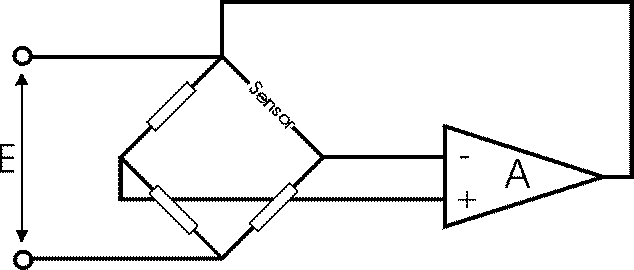Материал взят с http://www-g.eng.cam.ac.uk/whittle/current-research/hph/cta-circuit/cta-circuit.html
Constant Temperature AnemometersElectronic PrinciplesHot-wire and hot-film anemometers are normally operated in the constant temperature (CTA) mode, the electronic circuit for this being shown schematically in Figure 1. Since the resistance of a wire is proportional to its temperature, maintaining a constant resistance R of the probe means that its temperature is also kept constant. The voltage applied to the top of the Wheatstone bridge (i.e. the 'bridge' or 'output voltage') provides a measure of the heat transfer from the probe and this heat transfer is a measure of the fluid parameter under consideration at the time.  Figure 1 Basic circuit for constant temperature thermal anemometer
If it is assumed that
the bridge is essentially balanced at a certain condition then it can
be seen that a reduction in the resistance of the probe, due to an
increase in heat transfer causing a fall in temperature, will cause the
bridge to become unbalanced. This change will introduce a positive
error voltage at the input of the servo-amplifier. After considerable
amplification, the signal from the amplifier increases the bridge
voltage and hence also the current through the sensor, so that the
sensor is heated and the bridge balance is restored. In this way the
probe temperature is kept essentially constant and the effect of the
thermal inertia of the probe is minimised. P.S. СПАСИБО, ЧТО ПОСЕТИЛИ МОЮ СТРАНИЧКУ, УДАЧНОГО ВАМ ДНЯ!!! |
ДонНТУ |
Портал магистров ДонНТУ |
Реферат | Библиотека | Ссылки |
Отчет о поиске | Индивидуальное задание